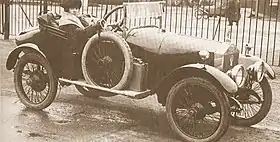Eric-Campbell
The Eric-Campbell was a British car made from 1919 to 1924 by Eric-Campbell & Co Limited of Cricklewood, London. The company was formed by H Eric Orr-Ewing and Noel Campbell Macklin.[2]
| Eric-Campbell | |
|---|---|
 | |
| Overview | |
| Manufacturer | Eric, Campbell & Co Ltd Vulcan Iron Works |
| Production | 1919-1926 |
| Powertrain | |
| Engine | 1498 cc in-line 4 cylinder |
| Transmission | three speed manual |
| Dimensions | |
| Wheelbase | 102 in (2,591 mm) [1] |
| Length | 144 in (3,658 mm) [1] |
| Chronology | |
| Successor | none |
Manufacturing
Eric-Campbell was formed by H Eric Orr-Ewing and Noel Campbell Macklin. Macklin subsequently founded Silver Hawk, Invicta and Railton car manufacturers.[2] Manufacturing took place in the factory of the Handley Page aircraft company in Cricklewood London. It is estimated that as many as 500 cars might have been made.[2]
Demise
Macklin left the company in 1920 to concentrate on his Silver Hawk car and by 1921 Eric-Campbell were in financial difficulties. In 1922 production was taken over by Vulcan Iron & Metal Works Limited of Southall, Middlesex.[3] Prices were reduced and a wider range of bodies offered. In its last year of 1924, Anzani engines could be ordered as well as the Coventry-Simplex.
The new owners failed to make a success of the company and the receivers were called in during January 1926.[3]
Eric-Campbell 10
The Eric-Campbell 10 (10/22 in 1924) was assembled from bought-in components with a Coventry-Simplex 1498 cc, four cylinder, side valve engine driving the rear wheels through a cone clutch and three speed Moss gearbox. The engine was tuned with a special camshaft and lightened pistons. Half elliptic leaf springs were fitted at the front whilst at the rear cantilever springing was used. A top speed of 55 mph was guaranteed and 60 mph claimed as possible.[2] Two seat polished aluminium bodies were fitted with a simulacrum of a Rolls-Royce radiator.
Competition
Two cars were entered in the tenth Targa Florio race in Sicily, held on 23 November 1919 and comprising 4 laps of the 108 kilometre Madonie circuit. The drivers were Cyril Snipe, who had won the 1912 event driving a SCAT 25/35, and Jack Scales (29 January 1886 – 23 October 1962) who subsequently raced for the Italian marque Chiribiri where he was known as l'Inglese Scalese (The Englishman Scales). Scales, driving car number 23 retired after 1 lap due to a broken steering arm, whilst Snipe did not complete a single lap in car number 24.[4][5]
In April and May 1920 Violette Cordery took part in two British Motor Cycle Racing Club handicaps driving an Eric-Campbell.[6]
Eric-Campbell 8
An 8 hp car, the 8/20, with 1075 cc engine was announced in 1924 but it seems not to have reached production.[1]
References
- Culshaw; Horrobin (1974). Complete Catalogue of British Cars. London: Macmillan. ISBN 0-333-16689-2.
- Baldwin, N. (1994). A-Z of Cars of the 1920s. Devon, UK: Bay View Books. ISBN 1-870979-53-2.
- G.N. Georgano, N. (2000). Beaulieu Encyclopedia of the Automobile. London: HMSO. ISBN 1-57958-293-1.
- The Nostalgia Forum at Atlas F1
- "Team Motor Racing Results database. Targa Florio 1919". Archived from the original on 24 September 2015. Retrieved 5 March 2014.
- Williams, Jean; Williams, Simon. "Cordery, Violette". Oxford Dictionary of National Biography (online ed.). Oxford University Press. doi:10.1093/ref:odnb/101214. (Subscription or UK public library membership required.)